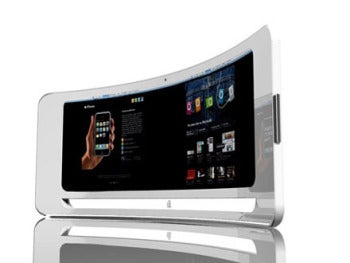Recent Posts
Saturday, April 28, 2012
Google Glass Innovation to Change Industry !!
Posted on 3:06 PM by Admin
 It's
hard to think of glass as an area of rapid technology evolution. But
it's one of the central technologies that will bring us incredible
innovations over the next couple of years.
It's
hard to think of glass as an area of rapid technology evolution. But
it's one of the central technologies that will bring us incredible
innovations over the next couple of years.
A combination of new technology, plus a strong desire on the part of
major companies to transform glass, will affect nearly every category of
consumer electronics, from smart watches to phones to tablets to
desktop computers to smart homes and offices.
Hundreds of companies and organizations are working on the coming glass
revolution. But here are four companies and one university that
announced serious breakthroughs recently, shattering old ideas about
what's possible with glass.
Google Wants Wearable Glass
Google's Sebastian Thrun appeared this week on the Charlie Rose program, and demonstrated Google's Project Glass for the first time in public.
The technology involves special glasses,
which use glass and mirrors to project a computer display onto one eye,
creating the illusion that relevant information is floating in the air.
Wireless connectivity and artificial intelligence enables you to
conjure up facts, see things in context, send messages by voice and even
take pictures by blinking.
He took the first-ever published photo taken by the glasses, and posted them on Google+ by simply nodding his head.
Google's research is moving fast, and it's validated the category. We're
going to see augmented reality products coming out this year that do
much of what Google is trying to do.
Apple Wants Curved Glass
Image source: 9to5Mac.comApple is totally smitten with the idea of curved glass.
The first place we've seen this obsession is in the ceilings of Apple stores. Apple even applied for a patent this week for its curved-glass ceiling design.
 In his presentation to the Cupertino City Council last summer about
Apple's proposed "spaceship" campus, Steve Jobs, the late Apple founder
and CEO, said there wouldn't be a single piece of straight glass in the
entire building.
In his presentation to the Cupertino City Council last summer about
Apple's proposed "spaceship" campus, Steve Jobs, the late Apple founder
and CEO, said there wouldn't be a single piece of straight glass in the
entire building.
But it's in Apple gadgets where the curved glass idea gets really exciting.
Rumors began circulating in September after Taiwanese magazine DigiTimes reported
(registration required) that Apple had purchased hundreds of
special-purpose machines for the factory manufacturing of curved-glass
displays. Some said the iPhone, or maybe the iPod, would become curved-glass devices.
The most compelling device for Apple would be a curved-glass wristwatch device, which controls other Apple products and interacts via iCloud.
I think it's likely we'll see such a product very soon.
Microsoft Wants Smart Glass
 I wrote a column in this space in October about Microsoft's vision for
the future of ubiquitous computing, which they illustrated with two videos.
I wrote a column in this space in October about Microsoft's vision for
the future of ubiquitous computing, which they illustrated with two videos.
Microsoft's predictions are all based on what current research will make
possible or affordable in the future. Many of these ideas are based on
major breakthroughs in the cost, quality and functionality of glass.
For example, Microsoft envisions augmented-reality taxicab windows,
wall-size displays and computer displays on surfaces like kitchen
counters.
A theme is that computer displays can also be see-through. And, in fact, Microsoft developed a prototype for technology that uses transparent displays, called the see-through 3D desktop.
It's a foregone conclusion that transparent computer displays will be
cheap and ubiquitous in the near future. I don't believe Microsoft will
be directly involved in the making of such products, but many companies
will be building innovative smart-glass display technologies that will
roughly mirror Microsoft's vision (including smart mirrors).
Gorilla Glass Gets Even Better
has already changed the mobile industry. But most consumers don't know the role Steve Jobs had in making that happen.
Corning engineers invented the technology behind Gorilla Glass in the
1960s. At the time, they couldn't find any commercial applications for
it so the project just stopped.
Fast forward to 2006. Apple was finalizing materials for the upcoming
iPhone, and Jobs was dissatisfied with the hard plastic that many
phones, including the iPhone prototype, used for displays. The biggest
complaint was that they scratched too easily. At the time, plastic was
preferred because glass was considered too breakable for phones.
Image source: www.corning.comSo
Jobs called the CEO of Corning to find out if that company could
develop a super-hard, scratch-resistant glass for Apple products.
Corning brought the old '60s project back to life and called it Gorilla
Glass. Now, it's the standard for mobile devices and found in 600
million devices.
A new version introduced this year, called Gorilla Glass 2, which is just as strong but 20% thinner, will help smartphones and tablets continue to get thinner and lighter without sacrificing durability.
Corning has another glass technology that could really change things for consumer technology. The new glass is both flexible and very thin.
The flexibility enables the manufacturing process to resemble how
plastic is made, on factory rollers. It has all the scratch- and
heat-resistance of glass.
The company envisions the use of this technology to make wall-size touch
displays, for example, and tiny mobile phones that are very thin, light
and low cost.
The company also announced this week a new glass technology that kills bacteria and viruses, including scary antibiotic-resistant super bugs. This will be great for medical tablets, and possibly for consumers.
MIT Reinvents Glass
Glass is shiny and causes glare, which makes screens harder to read in
bright light. It also reduces the efficiency of solar cells.
MIT researchers this week announced a breakthrough
in glass technology that solves the glare problem. The glass has a
revolutionary surface pattern made of nano-scale cones of glass.
It's called multifunctional glass. It's very clear, without glare or reflection.
 The
glass also deflects water, which bounces right off. Car windshields
using the glass, for example, would not need windshield wipers.
The
glass also deflects water, which bounces right off. Car windshields
using the glass, for example, would not need windshield wipers.
More interestingly, solar cells under multifunctional glass would be
self-cleaning and would enable more light to penetrate through the glass
to the cells. It would be easy to imagine a phone like the iPhone 4
line with glass front and back, but with solar sells under the glass in
the back.
Smartphones, tablets, laptops and TVs would be essentially self-cleaning. No smudges and no glare!
The researchers are working on a patent and intend to develop the technology for consumer electronics.
What's great about all these ideas and technologies for consumer
electronics glass is that they're all about to come to market over the
next two years.
They'll transform the shape, size, performance and functionality of
everything we touch, and usher in a new world where glass is smart,
clear, weatherproof, self-cleaning and cheap!
For More Click Hare
Subscribe to:
Post Comments (Atom)
No Response to "Google Glass Innovation to Change Industry !!"
Leave A Reply